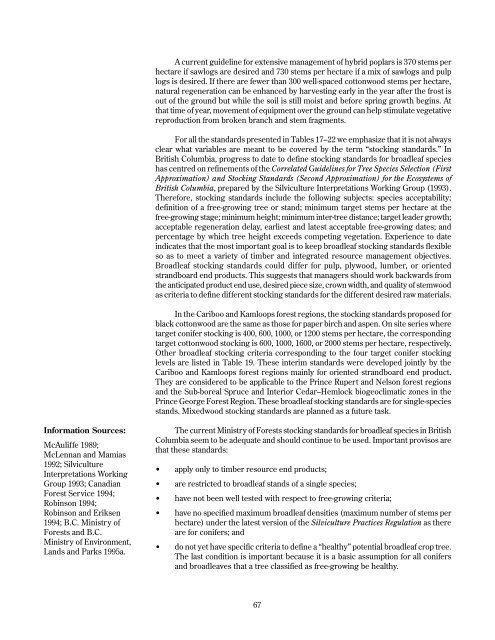FRDA Report: Black Cottonwood and Balsam Poplar Managers ...
FRDA Report: Black Cottonwood and Balsam Poplar Managers ...
FRDA Report: Black Cottonwood and Balsam Poplar Managers ...
You also want an ePaper? Increase the reach of your titles
YUMPU automatically turns print PDFs into web optimized ePapers that Google loves.
Information Sources:<br />
McAuliffe 1989;<br />
McLennan <strong>and</strong> Mamias<br />
1992; Silviculture<br />
Interpretations Working<br />
Group 1993; Canadian<br />
Forest Service 1994;<br />
Robinson 1994;<br />
Robinson <strong>and</strong> Eriksen<br />
1994; B.C. Ministry of<br />
Forests <strong>and</strong> B.C.<br />
Ministry␣ of␣ Environment,<br />
L<strong>and</strong>s <strong>and</strong> Parks 1995a.<br />
A current guideline for extensive management of hybrid poplars is 370 stems per<br />
hectare if sawlogs are desired <strong>and</strong> 730 stems per hectare if a mix of sawlogs <strong>and</strong> pulp<br />
logs is desired. If there are fewer than 300 well-spaced cottonwood stems per hectare,<br />
natural regeneration can be enhanced by harvesting early in the year after the frost is<br />
out of the ground but while the soil is still moist <strong>and</strong> before spring growth begins. At<br />
that time of year, movement of equipment over the ground can help stimulate vegetative<br />
reproduction from broken branch <strong>and</strong> stem fragments.<br />
For all the st<strong>and</strong>ards presented in Tables 17–22 we emphasize that it is not always<br />
clear what variables are meant to be covered by the term “stocking st<strong>and</strong>ards.” In<br />
British Columbia, progress to date to define stocking st<strong>and</strong>ards for broadleaf species<br />
has centred on refinements of the Correlated Guidelines for Tree Species Selection (First<br />
Approximation) <strong>and</strong> Stocking St<strong>and</strong>ards (Second Approximation) for the Ecosystems of<br />
British Columbia, prepared by the Silviculture Interpretations Working Group (1993).<br />
Therefore, stocking st<strong>and</strong>ards include the following subjects: species acceptability;<br />
definition of a free-growing tree or st<strong>and</strong>; minimum target stems per hectare at the<br />
free-growing stage; minimum height; minimum inter-tree distance; target leader growth;<br />
acceptable regeneration delay, earliest <strong>and</strong> latest acceptable free-growing dates; <strong>and</strong><br />
percentage by which tree height exceeds competing vegetation. Experience to date<br />
indicates that the most important goal is to keep broadleaf stocking st<strong>and</strong>ards flexible<br />
so as to meet a variety of timber <strong>and</strong> integrated resource management objectives.<br />
Broadleaf stocking st<strong>and</strong>ards could differ for pulp, plywood, lumber, or oriented<br />
str<strong>and</strong>board end products. This suggests that managers should work backwards from<br />
the anticipated product end use, desired piece size, crown width, <strong>and</strong> quality of stemwood<br />
as criteria to define different stocking st<strong>and</strong>ards for the different desired raw materials.<br />
In the Cariboo <strong>and</strong> Kamloops forest regions, the stocking st<strong>and</strong>ards proposed for<br />
black cottonwood are the same as those for paper birch <strong>and</strong> aspen. On site series where<br />
target conifer stocking is 400, 600, 1000, or 1200 stems per hectare, the corresponding<br />
target cottonwood stocking is 600, 1000, 1600, or 2000 stems per hectare, respectively.<br />
Other broadleaf stocking criteria corresponding to the four target conifer stocking<br />
levels are listed in Table 19. These interim st<strong>and</strong>ards were developed jointly by the<br />
Cariboo <strong>and</strong> Kamloops forest regions mainly for oriented str<strong>and</strong>board end product.<br />
They are considered to be applicable to the Prince Rupert <strong>and</strong> Nelson forest regions<br />
<strong>and</strong> the Sub-boreal Spruce <strong>and</strong> Interior Cedar–Hemlock biogeoclimatic zones in the<br />
Prince George Forest Region. These broadleaf stocking st<strong>and</strong>ards are for single-species<br />
st<strong>and</strong>s. Mixedwood stocking st<strong>and</strong>ards are planned as a future task.<br />
The current Ministry of Forests stocking st<strong>and</strong>ards for broadleaf species in British<br />
Columbia seem to be adequate <strong>and</strong> should continue to be used. Important provisos are<br />
that these st<strong>and</strong>ards:<br />
• apply only to timber resource end products;<br />
• are restricted to broadleaf st<strong>and</strong>s of a single species;<br />
• have not been well tested with respect to free-growing criteria;<br />
• have no specified maximum broadleaf densities (maximum number of stems per<br />
hectare) under the latest version of the Silviculture Practices Regulation as there<br />
are for conifers; <strong>and</strong><br />
• do not yet have specific criteria to define a “healthy” potential broadleaf crop tree.<br />
The last condition is important because it is a basic assumption for all conifers<br />
<strong>and</strong> broadleaves that a tree classified as free-growing be healthy.<br />
67

















